China has a long history of using women as objects d'art since the Warring States and Western Han Dynasty when people painted female figures on silk.
Each time in history has its own idea of 'beauty' and from early times artists have recorded their particular version of 'beauty'. Artists in China are no different. Throughout the ages, the image of the 'ideal' beauty has been subject to the trends and politics of the times, and through their legacies we can gain a better understanding of Chinese history.
Even though paintings of women were common, women did not gain respect because of it. In the paintings women are only beautiful objects to show or admire. It is possible to link the growth of women depicted in art and a lowering of their social status.
Southern and Northern Dynasties
The early stages of traditional Chinese depictions of beauty began in the Southern and Northern Dynasties (420-589). Virtuous women and fairies composed the main subjects in these paintings, and they generally came from literary works.
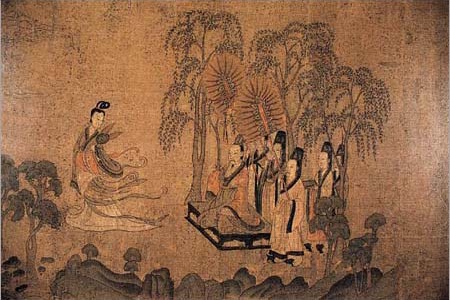
"Luoshen Appraisal Painting" by Gu KaizhiEastern Jin Dynasty(317-320) is a good example. Its theme was drawn from the story Luoshen Appraisal, penned by the famous writer of the Three Kingdoms (220-280) Cao Zhi, who was forced to part with his lover. Luoshen is the Goddess of the river Luo.
In the painting, Luoshen has delicate features and a slender body. Her expression is gentle. She did not show her joy when she encountered Cao Zhi or reveal her grief when he left. This shows Luoshen's refined character. With an original concept and heart-stirring scenes, the painting is considered a classic in Chinese art..
From the vivid description of the goddess, one can see that the typical image of beauty in that period was a thin,weak body as well as fragility graceful bearing.
Tang Dynasty
The Tang Dynasty was the most magnificent period in feudal society. During this time the traditional Chinese depictions of beautiful women also entered a new stage. Painters paid attention to the richly colorful society, and were especially interested in displaying the idle and carefree life of aristocrat women.
Artistic trends in any given historical period are influenced by social consciousness, cultural background and the economic development at the time. In the mid-Tang Dynasty (AD 618-907), after a hundred years of development, political power was stabilizing and the economy was prospering. Hedonism became increasingly popular among the ruling class.
The portrait painting style initiated by Yan Liben in the early Tang Dynasty which had aimed at praising national heroes, gradually lost its appeal. Even in many Buddhist paintings, the concubines of the rich were posed as goddesses, an indication that religious painting was becoming more realistic and temporal painting began to take on its initial form. Zhang Xuan and Zhou Fang were two representative artists of the time.

Zhou Fang's "Hui Shan Shi Nv Tu" (Court Ladies Wielding Fans) represents the outstanding achievements of depicting ladies of the court in the Tang Dynasty. Women in the pictures are vigorous, healthy, graceful and noble, representative of the magnificent beauty of the women during the prosperous Tang period.
Five Dynasties
After the Tang Dynasty painters in the Five Dynasties (709-960) not only inherited the Tang Dynasty tradition of painting beauty but also made changes.
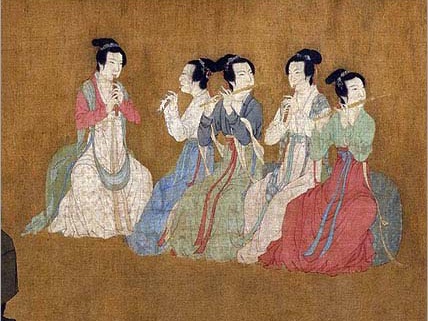
Take Gu Hong Zhong's "Han Xizai Evening Banquet " for example. The court attendant's posture is poor compared to that of the women in earlier Tang Dynasty paintings, but the woman is healthy and beautiful. In Ruan Gao's" Fairies of the Celestial Realm," there are also evident changes. Instead of painting obese models, he began to depict women with a more slender stature and charming posture.
Song Dynasty
With a relatively stable political power, developed economy and prosperous culture, Chinese artists in the Song Dynasty (960-1279), continued to make innovations in their portrayals of women.In addition to mythical female figures and courtesans, the women at the bottom of society began to catch artists' attention.Take Wang Juzheng's " The Spinning Wheel " for example. Women in this picture do not have sweet and pretty facial expressions, attractive statures, magnificent clothing or honored status. They are real, ordinary, rural women.
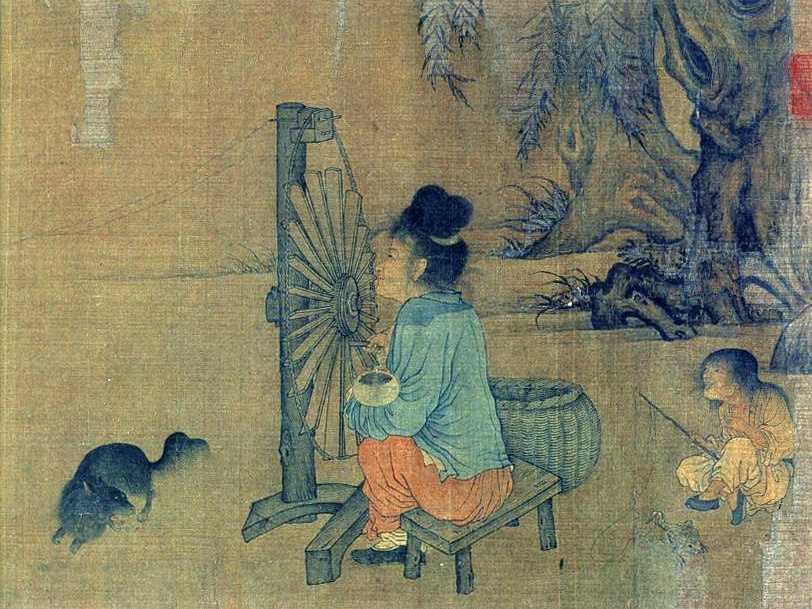
Artists did not use artistic techniques to make them look better, but praised their unadorned individuality and virtuous lifestyle while simultaneously expressing sympathy for their poverty.
Yuan Dynasty
During the Yuan dynasty, because of social turmoil and ethnic conflicts, many painters escaped to live in the mountains. They began to focus on painting the beauty of the nature that surrounded them, causing a decline in paintings of women.Painters did not continue the Song Dynasty tradition of positively displaying women of different classes. Instead they drifted away from depicting real life. They sought themes from historical stories as well as literary works. In terms of human modeling, they followed the customs handed down from the Tang Dynasty.
Ming Dynasty
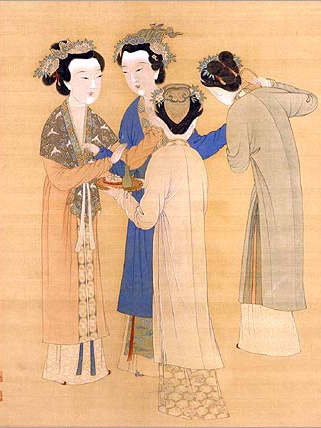
In the Ming Dynasty (1368 - 1644), there was an enormous development in the artists' portrayal of women. . Women's figures gradually started to have a certain aestheticism and symmetrical stature. Through solemn, simple and beautiful features the artists revealed their elegant manner.
Traditional Chinese painting entered its mature stage during the Ming Dynasty. Many outstanding painters emerged during this time.
Qing Dynasty
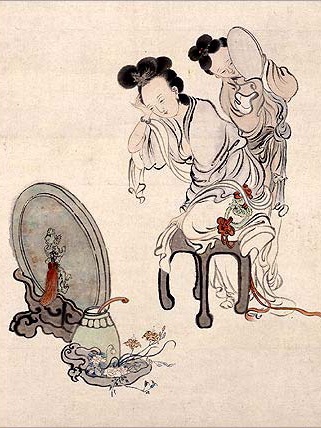
In the Qing Dynasty (1644-1911), paintings of women occupied an important place in art scene. Its status was above flower and bird painting,landscape painting and others.
During this period, the depiction of women in art became formulaic, showing women regardless of social status with slim figures, oval faces and cherry lips.
Female femininity and morbid beauty were also depicted by artists in the Qing Dynasty.



